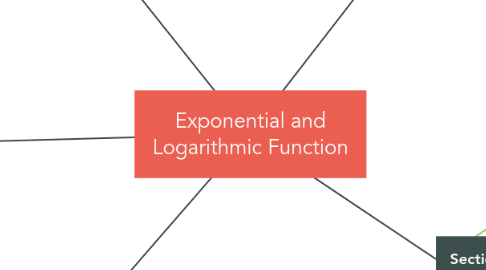
1. Section 3: Properties of Logs
1.1. Properties of Logs
1.1.1. Product Property
1.1.2. Quotient Property
1.1.3. Power Property
1.2. Use those (^) three properties to expand/condense logs.
1.3. Change of base formula:log(b)x=log(a)x/log(a)b
2. Section 4: Expon. & Log. Equations
2.1. Solve Equations using the One-to-One property.
2.2. Solving Logarithmic Equations
2.2.1. Condense if possible then use One-to-One property. Check for Extraneous Solutions.
2.3. Solving Exponential equations
2.3.1. With problems with an uncommon base take the log of each side and solve.
2.3.2. Exponential Equations in Quadratic Form can be solved through factoring.
3. Section 5: Modeling with Non-Linear Regression
3.1. Exponential Regression
3.1.1. Step 1: Make a scatter plot.
3.1.2. Step2: Find an exponential function to model the data.
3.1.3. Step 3: Graph the scatter plot and equation on the same screen.
3.1.4. Step 4: Use the model to make a prediction.
3.1.5. Do these steps with a variety of different types of graphs and use the best fit.
3.1.6. The graph with the r^2 value closest to one is the best fit.
4. Section 1: Exponential Functions
4.1. Problems Involving Growth and Decay
4.1.1. Use these equations: A=P(e)^rt, A=P(1+(r/n)^nt, N=No(1+r)^t, N=No(e)^kt.
4.1.2. Solve using a graph or by hand.
4.1.3. When using a graph to solve graph both sides and find the intercept.
4.2. Basics of Exponential Functions
4.2.1. In y=ab^x, a can't be 0 and can't be 1
4.3. Transformations of Exponential Functions
4.3.1. HDRV
4.3.2. y=k+a(b)^(x-h)
4.4. Graphing Exponential Functions
4.4.1. Function has the form of f(x)=ab^x.
4.4.2. Important points include (-1,.5), (0,1), (1,2).
4.4.3. Has a horizontal asymptote at y=0.
5. Section 2: Logarithmic Functions
5.1. Logs are just exponents
5.1.1. log(2)4=2, 2^2=4
5.2. Evaluating Logs
5.2.1. Step 1: In log(3)81 set it equal to x.
5.2.2. Step 2: Put it into exponential form.
5.2.3. Step 3: Make all terms have the same base.
5.2.4. Step 4: Use prop. of equality for exponents then solve.
5.3. Properties of Logs
5.3.1. Common log has a base of ten and natural log has a base of e.
5.3.2. log(b)b^x=x, b^log(b)x=x
5.4. Graph of a log
5.4.1. Inverse of Exponential Functions
5.4.2. Asymptote at x=0
5.4.3. Important points at (.5,-1),(1,0),(2,1).
5.4.4. HDRV

